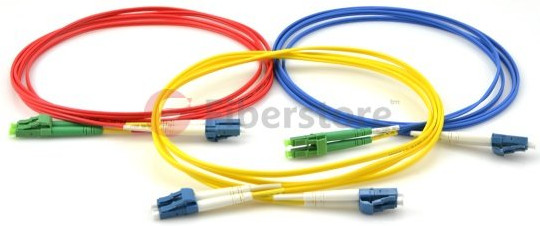In modern life, copper wires have given way to fiber optic patch cables due to the rapid advancements in optic technology. And fiber patch cables have been widely used to meet increasing demands for greater bandwidth and higher-speed data transmission in the telecommunication industry. Then, how much do you know about fiber patch cables? The following passages will involve essential information about fiber patch cables.
Fiber patch cables, also called fiber jumper cables, are fiber optic cables made of pure glass. They terminate with optical connectors on one or two cable ends, deployed to link optical equipment and components to achieve data transfer and Internet connectivity between devices. They are characteristic of low insertion loss and high return loss, high durability (more than 500 times mating), coupled with temperature stability (operating temperature: -20 to +75 ℃). For those key features, more and more people have begun to choose fiber patch cables as network transmission medium in optical network systems. Besides, their delicacy and great ability in transmitting data over either short or long distances earn reliability and trust from users.
Fiber patch cables are often utilized in communication rooms, FTTH (Fiber to The Home), LAN (Local Area Network), data processing networks, premise installations, etc. In addition, CATV (Cable Television) connections also apply them for signal transmission, including audio and video images. In a word, fiber patch cables are almost everywhere in telecommunication systems.
Fiber patch cables can be divided into several types according to different standards. By number of fibers and connectors standard, fiber patch cables mainly fall on two kinds, simplex and duplex patch cables. The former has one fiber and one connector, while the latter has two fibers and two connectors on both ends.
Based on connector construction, fiber patch cables are designed in FC, SC, ST, LC, MTRJ, MPO, MU, SMA, FDDI, E2000, DIN4, and D4 types. And some of the most common cable configurations include FC-FC, FC-SC, FC-LC, FC-ST, SC-SC, and SC-ST.
When it comes to transmission media, two typical types are single-mode and multi-mode patch cables. Single-mode fiber patch cables, usually in yellow, have one core and one pathway of light, which leads to more focused light at the center of a core. Thus, they more suitable for transmitting data over longer distances, and are used in college campuses and cable TV. As for multi-mode cables, usually in orange, they have a larger core diameter and multiple pathways of light, so they can gather more light and signals than single-mode ones over shorter distances. And they are often applied in LED sources and alarm systems.
In single-mode patch cord series, one specific cable should attract people’s attention, LC to LC duplex single mode, one of the most reliable and affordable cables. It has two fibers and two connectors on each end with a core of 9/125μ (micron). It can send one light signal at a time, and can be used for longer runs up to 10 kilometers because it has much resistance to attenuation. The following figure shows LC-LC Duplex 9/125 Single-mode Fiber Patch Cables.

Fiber patch cables play a really important part in telecommunications for making transmission faster and more accurate. As a leading manufacturer of optical products, Fiberstore can offer those above-mentioned types of patch cables. Armored patch cables, fiber optic pigtails and other special patch cable are also available in it. For more information about fiber patch cables, please visit Fiberstore.